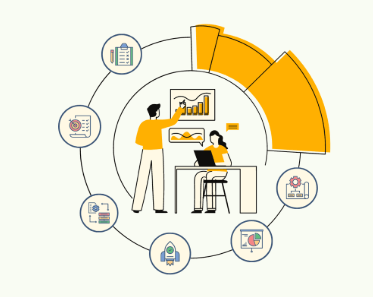
The Data Science Lifecycle: From Data Collection to Decision-Making
Data science is at the forefront of decision-making in the current digital era, propelling advances in various industries. The need for data-driven insights has increased due to the proliferation of data from multiple sources, including social media, IoT devices, e-commerce platforms, and more. Data science has become essential for companies trying to stay ahead of the competition, whether in the healthcare, financial, or retail sectors.
The lifecycle of data science is a methodical, iterative process that turns unprocessed data into insights and decisions that can be implemented. Both seasoned practitioners and professionals must comprehend this lifecycle. Programs like the esteemed MIT Data Science program or a PGDM in Data Science give students the skills to negotiate this challenging process successfully.
In this blog, we will thoroughly examine the data science lifecycle, covering its phases, difficulties, and best practices to enable you to develop significant solutions.
What is the Data Science Lifecycle?
The entire process of resolving data-driven issues is guided by the structured framework known as the data science lifecycle. It starts with comprehending the Problem and provides helpful information that influences choices. The lifespan is an iterative loop in which each stage feeds into and improves the others, guaranteeing continual improvement rather than being a one-time linear procedure.
This process is necessary to extract precise, trustworthy, and significant insights from unprocessed data. Every lifecycle phase is intended to tackle specific issues and guarantee that data-driven solutions complement corporate goals.
Key Stages of Data Science Lifecycle
1. Defining Problem
A clear challenge is the first step in any successful data science endeavour. Without a precise aim, the entire process risks losing focus.
Key Considerations:
- Involvement of Stakeholders: Work with stakeholders to comprehend their expectations and problems.
- Explain Success Measures: Set quantifiable KPIs, like increased operational efficiency or prediction accuracy.
- Contextual Awareness: Match goals to industry-specific specifications.
For example, a healthcare provider would concentrate on forecasting patient readmission rates, while a fintech company might try to shorten the time it takes to detect fraud.
Real-World Example
A retail business experiencing a drop in sales may wish to determine the rates of client attrition. By identifying the issue, the data science team can create a model that forecasts which customers are most likely to depart and why.
2. Data Collection
Data collection is the foundation of any data science effort. The calibre, volume, and applicability of the data gathered directly impact the results.
Key Steps in Data Collection
- Identifying Data Sources: online scraping, external datasets, APIs, or internal databases.
- Methods of Data Collection: To obtain pertinent data, use surveys, Internet of Things devices, or system logs.
- Ensuring Data Privacy: Following laws like GDPR or HIPAA to guarantee moral data use.
Tools and Techniques
- SQL: Used to query structured databases.
- Web scraping tools, including BeautifulSoup and Scrapy, are used to collect unstructured data.
Example
A marketing team may gather information about consumer interactions from email campaigns, social media platforms, and e-commerce websites to provide tailored recommendations.
3. Data Cleaning and Preparation
Raw data is frequently unreliable, disorganized, and lacking. The dataset is guaranteed to be accurate, complete, and analysis-ready through data cleaning and preparation.
Key Activities
- Dealing with missing values: To deal with missing values, interpolate, replace, or eliminate missing data points.
- Standardizing formats: Assure uniformity in data types, timestamps, and units by standardizing formats.
- Eliminating Noise: Focus on essential patterns by filtering out unimportant information.
Tools Used:
- Pandas, NumPy, and OpenRefine are Python libraries used for data manipulation.
- The Extract, Transform, and Load (ETL) pipelines streamline the workflow.
Importance
About 60–80% of the work in a data science project is dedicated to data cleaning. Ignoring this step could lead to incorrect insights and models.
4. Exploratory Data Analysis (EDA)
At EDA, the data starts to tell its narrative. This step entails viewing and analyzing the data to find trends, correlations, and anomalies.
EDA Techniques
- Data Visualization: Tools such as Tableau, Seaborn, and Matplotlib facilitate the creation of comprehensible graphs and charts.
- Correlation Analysis: Determine how variables relate to one another to inform feature selection.
- Statistical Analysis: Use summary statistics (mean, median, variance) to comprehend the distribution of data.
Example
EDA may be used by a sales team examining quarterly revenue to determine seasonal patterns or how discounts affect consumer buying.
5. Model Construction
Model building is fundamental to the data science lifecycle. In this step, predictions or classifications are made using statistical or machine learning methods.
Key Activities
- Algorithm Selection: Depending on the nature of the Problem, select algorithms such as clustering, decision trees, or neural networks.
- Training and Testing: Separate the dataset into training and validation sets to assess model performance.
- Hyperparameter Tuning: Modify parameters to maximize the precision and effectiveness of the model.
Frameworks and Tools
- Scikit-learn: Perfect for putting machine learning methods into practice.
- Two popular tools for deep learning applications are TensorFlow and PyTorch.
Real-world Application
An insurance business may employ clustering techniques to divide clientele by risk profile or classification models to forecast claim approvals.
6. Model Evaluation
Building a model is not enough; it must function well in real-world scenarios. Model evaluation guarantees the solution’s accuracy, dependability, and robustness.
Evaluation Metrics
- Classification Models: F1 score, recall, accuracy, and precision.
- Regression Models: Mean Absolute Error (MAE) and Root Mean Square Error (RMSE) are two examples of regression models.
- Cross-Validation: To make sure the model is generalizable, use k-fold cross-validation.
Example
A fraud detection model should have a high recall to detect fraudulent activity and a high precision to prevent false positives.
7. Deployment
The intersection of theory and practice is deployment. Real-time insights are produced by integrating models into production systems.
Steps in Deployment
- System Integration: Integrate the model with already-existing software systems.
- API Creation: To provide easy access, use RESTful APIs.
- Monitoring and Updates: Monitor performance and adjust when data patterns change.
Deployment Tools
- Cloud Platforms: For scalable solutions, use Azure, Google Cloud, or AWS.
- Docker and Kubernetes: Assure portability and effective resource management with Docker and Kubernetes.
Example
A recommendation engine in use in e-commerce could make dynamic product recommendations in response to user activity.
8. Business Impact and Decision-Making
The lifecycle’s last phase involves turning insights into calculated moves. This is where data science’s true worth becomes apparent.
Activities
- Actionable Insights: Make explicit, fact-based suggestions to stakeholders.
- Business Implementation: Align tactics with company objectives, including cutting expenses or growing the market.
- Impact Assessment: Evaluate how well data-driven choices work.
Example
A telecom company can increase customer happiness and return on investment by launching customized marketing campaigns based on customer segmentation insights.
Data Science Lifecycle Applications
- Healthcare: Medicine Forecasting disease outbreaks, refining treatment strategies, and tailoring care.
- Finance: Credit scoring, algorithmic trading, and fraud detection.
- Retail: Sentiment analysis, personalized suggestions, and inventory management.
- Education: Organizations like MIT Data Science utilize advanced analytics to improve curriculum design and student results.
Read also: Career Development in the Tech Industry
Data Science Lifecycle Challenges
- Data Quality Issues: Missing or inconsistent data can distort outcomes and lower model accuracy.
- Scalability: Extensive dataset handling calls for sophisticated tools and a strong infrastructure.
- Ethical Concerns: Ensure that data privacy laws are followed and fairness and transparency are maintained.
- Model Interpretability: Deep learning and other complex models cannot be transparent, making interpreting the results challenging.
Professionals enrolling in programs like MIT Data Science or pursuing a PGDM in Data Science gain hands-on experience in statistics, machine learning, and decision-making. With an emphasis on practical applications, these programs enable students to tackle problems in various industries.
Conclusion
The Data Science Lifecycle is a potent paradigm that drives efficiency and innovation across industries by converting unstructured data into insightful decisions. Effective solutions need mastery of every step, from problem characterization to actionable insights.
A PGDM in Data Science or courses from MIT Data Science offers the ideal setting for prospective data professionals to establish a solid foundation in an ever-evolving subject. By comprehending and utilizing the lifecycle, you can significantly influence how data-driven decision-making develops in the future.
Start your path now because there are countless opportunities in the field of data science.




